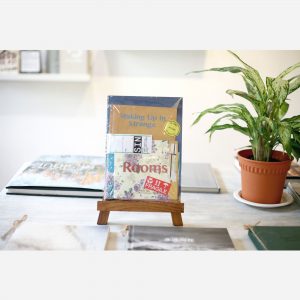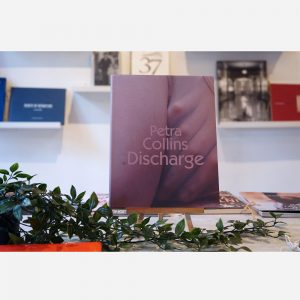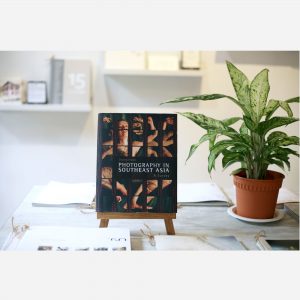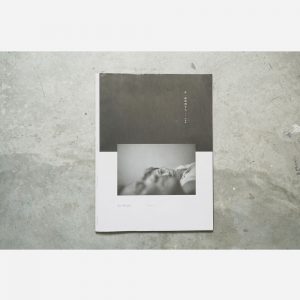| BY | Ying Ang |
| YEAR | 2014 |
| DETAILS | Chevron patterned hardcover with pale pink screen printed box, featuring diamond shape cut out. 9.6 x 11.2 inches in size, 132 pages with 72 colour images. Additional newspaper zine insert. Offset printing on matte coated paper in the Netherlands.ISBN 9780692225943 |
GOLD COAST by Ying Ang
$90.00
“Simultaneously touted as the crime capital as well as the tourist capital of Australia, the South Coast was a straggly and dangerous strip of coastline that was renamed to Gold Coast by real estate developers in an effort to seduce investors, retirees and holiday-makers. In a huge push to attract potential home owners through the 60’s and 70’s, a vast network of canals was constructed to provide for waterfront homes, complete with an unexpectedly large population of bull sharks that lurk in the shallow depths. This relationship between selling the idea of the perfect home and pervading danger is evident in the local news, that fluctuates between million dollar listings and tales of sleaze and murder. State Government corruption and unethical business practices through the 80’s and property scams in the 90’s cemented the Gold Coast as the perfect place for Australians of ill repute to come and reinvent themselves.
I lived in this city for 17 years and in that time, my friends and I were witnesses to a range of crimes from rape to stabbings in a ubiquitous background of racism, illegal drugs, extortion, boats and mansions. The insidious nature of this city was not in the rocketing crime rate that graces the newspaper on a daily basis, but in the aesthetics of an upwardly mobile and predominantly Anglo-Saxon community in combination with sunshine and kilometers of sandy beach, leading to a blanket denial of its residents to confront the reality of the environment they live in.
In the same way that we have icons of danger (broken windows, public housing), we also have icons of safety (swimming pools, perfect lawns). The Gold Coast exemplifies how powerful these icons can be in insulating our opinions from our knowledge of what we know to be true. It manifests a mentality that confirms one’s security based on superficial checkpoints that have been identified by contemporary consumerist values. Everything will be ok so long as it looks ok, no matter the proof of things rotting from the inside.
This series of images was made on the premise that environments of safety and danger cannot be delineated by weather and architecture. “A sunny place for shady people”, the Gold Coast became known as a perfect strip of golden beach where execution style shootings at the local mall were whispered behind pastel colored walls and porcelain veneers. This is a tale about a place that laid the flawed foundation of its character upon a mirage of tranquility. It is about the price of sun drenched afternoons hashtagged “grateful”. It is about our perceptions of safety and danger within the architecture of our built environment. It is about real estate and the beautiful lie bought and sold here every day.”
— Ying Ang on Gold Coast
As seen in:
LensCulture
Time Lightbox
About Ying Ang
Based in Melbourne, Australia, Ying Ang is an established photographer and author with extensive international exhibition history and has worked with The New York Times, The Atlantic, Wall Street Journal, Time, Vice, Huck, Wallpaper, The Fader magazines, Lucasfilm and AirBnB. She graduated as valedictorian in the 2009-2010 class of Documentary Photography and Photojournalism at The International Centre of Photography, with a subsequent award and portfolio acquisition for the permanent collection of the Sagamihara City Museum in Japan.
Her first artist book, Gold Coast, won the New York Photo Festival and Encontros Da Imagem book prize for 2014, was a finalist for Australian Photobook of the Year, the CREATE Award, the Guernsey Photography Festival Prize for 2015 and acquired for the Rare Books Collection at the Victorian State Library. Gold Coast was also honoured with a nomination for the prestigious Prix Pictet award.
In 2019, her latest work, The Quickening (FKA Bower Bird Blues), was a Vevey Images Grand Prix finalist in Switzerland, honorably mentioned in the Julia Margaret Cameron Award, winner of the 2020 BIFA Documentary Photo Book Prize, finalist for the 2020 Lucie Foundation Prototype Photo Book Award and the PHOTO 2021 International Photobook Prize. The project was exhibited in a solo show during Rencontres d’Arles in France in 2019.
2 in stock









